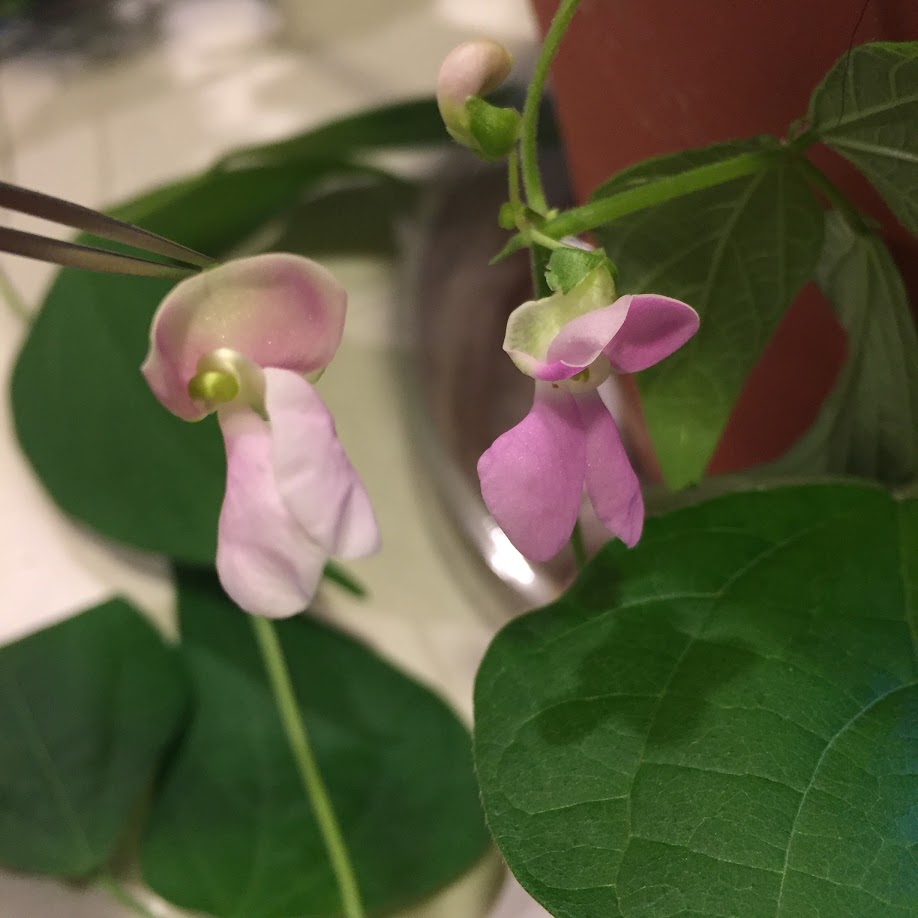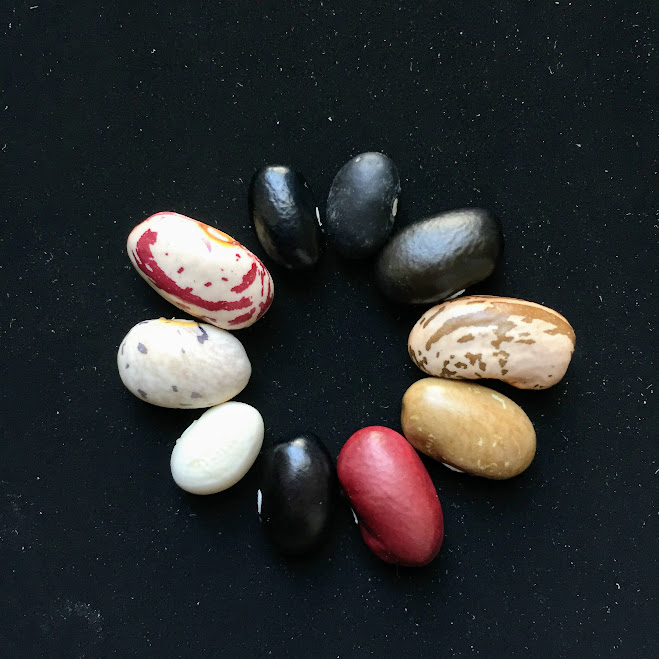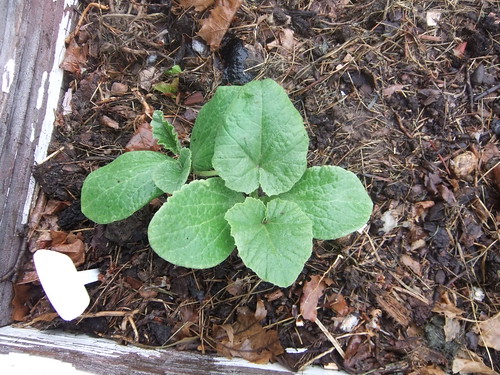|
|
Post by racehggns on Dec 4, 2016 20:42:51 GMT -5
I work/study with soybeans, and I wanted try out my hand with some common beans the summer of 2016. After I learned black, pinto, navy, northern, kidney, pink, cranberry, and numerous others were all the same species Phaseolus vulgaris, I was fascinated! I chatted with a former post doc in my lab who worked with common bean quite some time, and he encouraged me to try out some crosses. They even have a unusual history of being domesticated twice from two separate wild gene pools, resulting in distinct Mesoamerican (small beans like black, navy, pinto) and Andean germplasm (large beans like kidney and cranberry) which makes for a great evening read, right? The complex domestication history of the common bean
I started with 9 varieties I grew from a Hy-Vee All Natural Nine Bean Soup Mix and the ingredients listed "Black Beans, Pink Beans, Pinto Beans, Small Red Beans, Navy Beans, Yellow Beans, Cranberry Beans, Great Northern Beans, Light Red Kidney Beans." A lazy way to get different beans, but I just wanted to test some out. I'd love to get my hands on more varieties! I planted 1-2 plants of each variety in pots and attempted crosses with at least two other varieties.  Photo 1: A pink kidney bean flower on the left and a purple F1 kidney x northern? flower on the right. The northern had white flowers and white seed coat, so I think it's possible for the purple flower color to show up in the F1. Otherwise, it may be a hybrid with a black bean and I mixed labels, but my black F1's had dark veins at the throat of the flower, so I'm just completely unsure! I will wait for the seeds to develop.  Photo 2: From left to right, navy x cranberry F1 pod, pinto x red F1 pod, and black x pinto F1 pod. I'm particularly fond of the navy x cranberry pod, the navy mother had green pods with no stripes.  Photo 3: From left to right, same pinto x red F1 pod and black x pinto F1 pod from photo 2, now with a cranberry x black F1 pod on the right.  Photo 4: The father red bean and mother pinto bean above and the F1 solid brown bean below. I would love thoughts of the proposed color genotypes for some of these beans.  Photo 5: A half-sib circle: each bean is genetically half the bean adjacent. Going clockwise starting with the solid red bean on the bottom, and jumping every other bean are small red, navy (white), cranberry (red speckled), black, and pinto (brown speckled). The F1 beans are wedged between each parent. I have a few other F1 beans growing under LED lights right now and will add more pictures as they develop. |
|
|
|
Post by keen101 (Biolumo / Andrew B.) on Dec 4, 2016 21:58:20 GMT -5
Wow! This is great. Just the kind of thing I've been hoping to see lately. After finally starting to see some interesting pea crosses this year i've started to think about adding bean crossing to my projects. In particular i was saddened to find out one of my favorite childhood beans (The Black N.M. Appaloosa bean) to now be extinct, at least from what i can tell. The good news is i find some viable beans of the almost identical Red New Mexico Appaloosa beans (aka. Gila River Bean) that i grew for the first time in 2016. Some of them did quite well. I'm thinking that one of my crossing projects will be to try and recreate the Black N.M. Appaloosa bean by crossing the red version with the similar but smaller and non-kidney shaped orca / vaquero beans. I'd like for fun to also try crossing the other "Anasazi-like" beans to each other as well and see what interesting results i get. I currently have Anasazi bean, Four Corner's Gold / Zuni bean, Gila River bean, Vaquero beans, Rio Zape bean, Great Northern Bean.
Actually i still need to take a picture of the beans i harvested this year. (will do that soon). But i also noticed a few interesting beans that look like natural crosses. One of such crosses i suspect is a cross between the Rio Zape Bean and the Zuni Gold bean. It has a small pinto bean shape with flat edges but it retains mostly the Rio Zape pattern and coloring which is interesting. There are also a few other natural looking crosses that i need to pick out and take pictures of.
There has been a few pictures from others this year from their natural bean crosses too i think. I need to go back and reread those threads.
Note: I'm having trouble viewing some of your pictures. Perhaps a google image permission thing is going on there? I can see the first couple ones, but not the last three or so.
|
|
|
|
Post by steev on Dec 4, 2016 23:12:17 GMT -5
racehggns: well done, very informative. It's always encouraging to see people younger than so many of us jumping on this stuff.
|
|
|
|
Post by racehggns on Dec 4, 2016 23:14:26 GMT -5
It would be great to see additional pictures of everyone's crosses! I can now see there are several threads with posts of natural crosses with excellent pics.
I think I can push another generation this winter and attempt some four-way crosses. Maybe other gardeners online have some cultivars to recommend to add to this mish-mash of crosses? I think it would be great to swap some of my limited F2 seed with people willing to grow them out. Right now I am just having fun mixing the genepool for the sake of it, who wouldn't?
|
|
andyb
gardener
  
Posts: 179
|
Post by andyb on Dec 4, 2016 23:45:57 GMT -5
Welcome, and thanks for the pictures!
For the crosses, are you using the trip and hook technique, doing full emasculations, or something else?
|
|
|
|
Post by racehggns on Dec 5, 2016 10:41:05 GMT -5
Welcome, and thanks for the pictures! For the crosses, are you using the trip and hook technique, doing full emasculations, or something else? I found this helpful .pdf online Crossing Dry Bean (Phaseolus vulgaris) from the Dry Bean Breeding and Genetics Lab at Michigan State University and I copied their method, but I additionally emasculated the female. I found having the male donor stigma firmly hooked seems to be the key, and choosing a female that is just about to open had more pod set. I tried pollinating very immature female flowers (like in soybean), but alas almost always aborted! |
|
andyb
gardener
  
Posts: 179
|
Post by andyb on Dec 5, 2016 23:09:24 GMT -5
I found this helpful .pdf online Crossing Dry Bean (Phaseolus vulgaris) from the Dry Bean Breeding and Genetics Labat Michigan State University and I copied their method, but I additionally emasculated the female. I found having the male donor stigma firmly hooked seems to be the key, and choosing a female that is just about to open had more pod set. I tried pollinating very immature female flowers (like in soybean), but alas almost always aborted! Yeah, that's a good reference, and is really helpful when starting out. I've been doing a bunch of crosses over the last year or so, focusing on interspecific hybrids in the vulgaris group, and it sounds like we're using the same basic technique. I sort of paint the pollen from the donor's stigma onto the recipient's stigma, hook, and then pack the flower back into its bud and clamp it closed with a piece of twisty-tie. For female buds, I try to catch them the day before they open, though I've made a few successful crosses with flowers that were two days from opening. I've never tried any crosses between the meso and andean groups, but have heard that growing plants from the F1 seeds can be difficult. Did you have any trouble? I look forward to comparing notes! |
|
|
|
Post by racehggns on Dec 10, 2016 11:27:15 GMT -5
|
|
andyb
gardener
  
Posts: 179
|
Post by andyb on Dec 18, 2016 0:52:15 GMT -5
I posted a picture of some common x runner F1 seeds on another thread. |
|
|
|
Post by racehggns on Jan 2, 2017 11:58:38 GMT -5
Here's an update on from my earlier post, where I posted a picture of my kidney x northern? flower.  Photo 1: Light red (pink) kidney beans and pod top left, great northern beans and pod top right, and the beans and pods from the F 1 in the lower half. I had a feeling the seeds would be black after seeing the dark purple stripes on the developing pod.  Photo 2: Close up of the beans. I like the light flecking on the black background, and I remember somebody else showing a cross in another thread that had similar markings. |
|
|
|
Post by philagardener on Jan 2, 2017 14:03:09 GMT -5
Cool stuff! I wonder if the parent's pigmentation pathways are complementing to give the black (presumably anthocyanin) color in the F1.
It will be interesting to see how things start to segregate from here!
|
|
|
|
Post by raymondo on Jan 2, 2017 16:15:36 GMT -5
Interesting and fun. I wonder how you tell which gene pool a bean belongs to.
|
|
|
|
Post by keen101 (Biolumo / Andrew B.) on Jan 2, 2017 16:40:14 GMT -5
Nice! Another great example of a dominant color trait being hidden underneath the white bean which lacks the color activation gene, but by crossing it to the red it suddenly is reactivated after all these generations. Though i'm not a fan of Darwin, i will add that Darwin saw something similar when he bred two white pidgeons together. They were both white, though one had black tail feathers and when they were crossed he got a blue pidgeon.
|
|
|
|
Post by flowerbug on Dec 28, 2019 10:27:54 GMT -5
i grow all sorts of beans. love the fun and eating them too. i have not updated my pictures recently with my camera breaking last year, so until i got the new one set up and my bean picture production line back into working shape this is what i have for pictures: www.anthive.com/project/beans/ |
|






